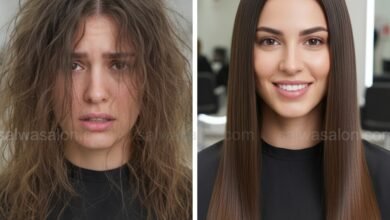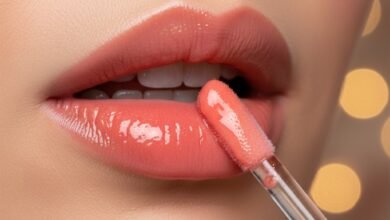Scientific Guide to Overcoming Oily Hair: From Hormonal Causes to Effective Solutions

Hair that feels greasy, flat, and heavy just hours after washing is a common problem that often lowers self-confidence. However, behind this discomfort lies a series of complex biological processes. Understanding why your scalp produces excess oil is the first and most crucial step to finding truly effective solutions, not just temporary fixes. At SalwaSalon.com, we believe that education is the foundation of true beauty.
This article is not just a list of tips, but an in-depth guide that will dissect the science behind oily hair. We will explore internal factors such as hormones and genetics, as well as external habits that may unknowingly worsen your condition. Get ready to transform your approach to hair care, from reactive to proactive and science-based.
Why Is My Hair Oily? Dissecting the Science Behind Sebum Production
The root of oily hair lies in one key element: sebum. This is a natural oily substance produced by the sebaceous glands attached to each hair follicle on your scalp. In balanced amounts, sebum is essential. It acts as a natural moisturizer that coats the hair shaft, protecting it from dryness and providing a healthy shine. However, when sebum production becomes excessive (a condition known as seborrhea), problems begin.
The Key Role of Sebaceous Glands and Internal Factors
Sebaceous glands do not work in isolation. Their activity is heavily influenced by various signals from within the body. Understanding these internal triggers is key to long-term management.
- Hormonal Fluctuations: This is a primary trigger for excessive sebum production. Androgen hormones, especially dihydrotestosterone (DHT), directly stimulate the sebaceous glands to produce more oil. This is why oily hair problems often peak during puberty, pregnancy, or menstrual cycles, where there are surges in hormonal activity.
- Stress and Cortisol: When you experience stress, your body releases the hormone cortisol. Scientific research has shown that cortisol can increase sebaceous gland activity, meaning the higher your stress levels, the greater the potential for your scalp to become an oil slick. Lack of sleep has a similar effect, as it disrupts the body’s hormonal balance.
- Genetic Factors: Often, the tendency to have an oily scalp is inherited within families. If your parents have similar issues, it’s likely that you also have larger sebaceous glands or ones that are more reactive to hormonal stimuli.
- Diet and Nutrition: What you consume can affect your scalp. Diets high in sugar and high-glycemic index foods can lead to insulin spikes, which in turn can stimulate androgen production and increase sebum production. Conversely, nutrients like Zinc and Vitamin B6 are crucial for helping to regulate oil production.
External Factors: Habits That Worsen the Condition
Beyond internal triggers, daily habits also play a significant role in determining how oily your hair is.
- Incorrect Washing Cycle: Washing too infrequently leads to a buildup of sebum, dead skin cells, and dirt that clogs follicles. Conversely, washing too often with harsh shampoos (containing strong sulfates like Sodium Lauryl Sulfate) can excessively ‘strip’ the scalp’s natural oils. As a result, the scalp will panic and actually produce more oil as compensation (a rebound effect).
- Improper Product Selection: Using shampoos and conditioners that are too moisturizing (intended for dry hair) will add burden to already oily hair. Ingredients like heavy silicones or concentrated oils can coat the hair and scalp, making it feel greasy and dirty faster.
- Excessive Heat: Heat from hair dryers, flat irons, and even overly hot shower water can stimulate the sebaceous glands. Heat dilates pores and glands, triggering greater oil release.
- Humid Environmental Conditions: High air humidity can make it harder for oil and sweat to evaporate from the scalp, causing hair to feel stickier and less fresh.
Holistic Strategies to Control Excessive Oil Production
After understanding ‘why’, it’s time to move on to ‘how’. Tackling oily hair requires a multifaceted approach, combining appropriate external care with internal support.
- 1. Care Foundation: Washing Technique and Active Ingredient Selection: This is the most fundamental step. Forget brands for a moment, and focus on ingredients that scientifically work to balance the scalp.Choose the Right Active Ingredients: When selecting a shampoo, look for products containing one of the following ingredients:
- Salicylic Acid: As a BHA (Beta Hydroxy Acid), this ingredient can penetrate oil to deeply cleanse scalp pores and remove dead skin cells.
- Tea Tree Oil: Known for its antimicrobial and anti-inflammatory properties, tea tree oil helps control the growth of Malassezia fungus (associated with dandruff) and soothes the scalp.
- Niacinamide (Vitamin B3): This superstar ingredient is clinically proven to help regulate sebum production and strengthen the scalp barrier.
- Zinc PCA: This compound helps control oil production without making the scalp too dry.
Correct Application Technique: Focus shampoo massage only on the scalp, where oil and dirt accumulate. Let the lather cleanse the hair shaft as it rinses. Avoid applying conditioner to the hair roots; use it only from the mid-shaft to the ends to moisturize without weighing hair down.
- 2. Weekly Treatment: Exfoliation and Balancing Masks: Just like facial skin, the scalp also requires regular deep treatment to reset its condition.Scalp Scrub (Exfoliation): Use a scalp scrub once a week before shampooing. Choose products containing physical exfoliants (like sugar or apricot particles) or chemical exfoliants (like Glycolic Acid/AHA). This helps remove product buildup, hardened sebum, and dead skin cells that can clog follicles.
Clay Mask: Kaolin or Bentonite Clay-based masks are very effective at absorbing excess oil. Apply to dry or damp scalp, leave on for 10-15 minutes before rinsing and following with shampoo. This is an excellent way to deep cleanse without harsh chemicals.
- 3. Styling and Daily Habits: Preventing Greasy Hair: Small changes in your daily routine can have a big impact on the appearance of your hair.Minimize Touching: Your hands carry oil and dirt. The more often you touch your hair, the faster oil transfers and makes your hair greasy.
Dry Hair Properly: Ensure your hair is completely dry before wearing a hijab, hat, or helmet. A damp and enclosed environment is an ideal breeding ground for fungi and bacteria, which can worsen itching and stale odor. When using a hair dryer, use a medium heat setting and keep it about 15-20 cm away from the scalp.
Use Dry Shampoo Strategically: Dry shampoo is a lifesaver for extending the time between washes. Spray it onto the roots from an adequate distance, let it sit for a moment to absorb oil, then massage and brush to remove any white residue. This is an effective cosmetic solution, not a treatment.
- 4. Inner Approach: Nutrition and Stress Management: Topical treatments will only be maximally effective if supported by good internal health.Focus on a Balanced Diet: Increase your intake of foods rich in Zinc (found in pumpkin seeds, lean meat), B Vitamins (green vegetables, eggs), and antioxidants (berries, green tea). Reduce consumption of refined sugars, excessive dairy products, and processed foods that can trigger inflammation and oil production.
Manage Your Stress: Implement relaxation techniques such as meditation, deep breathing, or yoga to lower cortisol levels. Regular exercise is also a fantastic way to manage stress and improve blood circulation to the scalp.
Conclusion: Consistency is Key to Healthy, Oil-Free Hair
Overcoming oily hair is not about finding one magic product, but about understanding your body and implementing a consistent and holistic approach. Start by identifying your potential primary causes—whether hormonal, stress-related, or incorrect care habits. Then, build a solid routine by choosing products based on scientifically proven active ingredients, complementing them with weekly treatments, and supporting them with a healthy lifestyle.
The journey to a balanced scalp requires patience, but with the right knowledge, you can take full control of your hair health. Use this as an opportunity to better understand the signals your body provides, and invest in sustainable, long-term solutions.






